Let’s take a look back at the scariest guy in comics, with the debut appearance of Marvel’s answer to Old Scratch himself, Mephisto.
Back in 1968, Marvel Editor-in-Chief Stan Lee had finally given a solo series to his favorite creation: the Silver Surfer. Stan was looking to create the ultimate villain for his noblest of heroes to face, as Stan described in his 1976 book BRING ON THE BAD GUYS:
“A man such as this, with power such as his, must inevitably be confronted by the most universally recognized symbol of evil on the face of the earth — the specter of Satan.”
Even so, Stan still didn’t want to come right out and use the Biblical Satan as a funny-book bad guy:
” Basically, it has always been my desire to have our stories savored for their enjoyment value primarily. Any moralistic or philosophical extras which might be thrown in are merely Marvel bonuses. Hence, I was reluctant to use the name Satan, or Mephistopheles, or Lucifer, or whatever. Names such as those would leave nothing in doubt. So I settled for a name which certainly had the sound of Mephistopheles, but we weren’t coming out and saying it. Besides, Mephisto is easier to spell.”
So it was that Mephisto made his first appearance in THE SILVER SURFER #3, (December 1968), in “The Power and the Prize!”, written by Stan Lee and drawn by John Buscema. Here we get our first look at Mephisto, as he senses the turmoil on the planet Earth, thrown into a panic by the Silver Surfer’s impetuous decision to grind to a halt all of mankind’s machinery, basically just to teach it a lesson.
Although the Surfer would soon have mercy and turn the lights back on, it serves to call attention to the Surfer in the eyes of Mephisto, who’s sickened by the Surfer’s nobility and declares that he must die:
Determining the Surfer’s Achilles’ heel right away, Mephisto travels to Zenn-La, the Surfer’s distant home planet, and appears in the chambers of Shalla Ball, the Silver Surfer’s beloved. Mephisto makes a simple offer, to bring her to Norrin Radd, which she accepts. Mephisto conjures up a spaceship, and off they go to Earth.
By the way, there’s a creepy sexual angle here with Mephisto and Shalla Bal, in the manner in which he makes the offer and her acceptance of it, all conveyed beautifully and disturbingly by John Buscema.
The Surfer recognizes the approaching craft as being from his homeworld, and quickly intercepts the defense missiles about to blow it from the skies:
The Surfer is shocked to discover Shalla Bal inside, but before they can enjoy their reunion, she’s spirited away by Mephisto:
Back in his hellish domain, Mephisto ponders how next to torment the Surfer, only to discover that he’d somehow been followed, thanks to the Surfer’s astounding tracking abilities. Here Mephisto explains to the Surfer the source of his power: man’s inhumanity to man.
Sensing that perhaps the Surfer could not be so easily destroyed, Mephisto tries to tempt him, first with riches…
…then with more physical temptations:
When the Surfer fails to succumb, Mephisto resorts to physical force, which again is rebuffed:
Finally at his wit’s end, Mephisto plays for keeps, reducing the Silver Surfer to a mere thought, and subsuming him inside his own consciousness:
Again, the Silver Surfer’s purity is too much for Mephisto to bear, and he’s returned to physical form.
Unable to destroy the Surfer, Mephisto must settle for tormenting him, whisking Shalla Bal back to Zenn-La and away from the Surfer forever, before the two can even touch:
Mephisto isn’t given a whole lot in the way of character development here in his debut, nor does he really need any. He’s the classic Satan figure in this story, an excellent counterpoint to Stan’s increasingly Christ-like Surfer. And while Stan does a fine job with Mephisto’s imperious, venom-dripping dialogue, it’s really John Buscema who truly brings the character to life, managing to at various points portray him as brooding, cowardly, and seductive, doing as much with body language as Stan does with dialogue (if not more) to convey Mephisto’s emotional state. Buscema also makes excellent use of shadow to often obscure Mephisto’s features, shrouding the character in mystery and making it all the more powerful when he’s fully revealed. Buscema, who never really considered himself a superhero artist, always was at his best when given a more fantasy-based realm in which to ply his trade, and his chilling design for Mephisto is a prime example of it.
When Mephisto was kept in this more mythological realm, such as his occasional appearances in THOR or DR. STRANGE, the character worked out just fine. However, when he crossed over into the company’s more traditional super-hero books, well the results could be a little hit-and-miss. One of the more successful appearances came in John Byrne’s FANTASTIC FOUR run, in “Suffer a Witch to Live…” from FANTASTIC FOUR #276 (March 1985).
At this point in the series, Reed and Sue Richards had moved out of the Baxter Building and into the Connecticut suburbs, in an attempt to create a more normal home life for their young son Franklin. Unfortunately, their nosy neighbor had glimpsed Reed and Sue using their powers (they were commuting to work in Manhattan at the time, with Reed using his elastic powers to change the shape of his face so as not to be recognized), and rather than jump to the more obvious conclusion (obvious at least in the Marvel Universe) that they were superheroes, she instead concludes that they’re witches, and summons a world-famous exorcist to come and clean up the neighborhood.
In one of the creepier moments, the exorcist opens up the pits of hell in the hopes of pulling the “witches” down in to the pit, and when Reed reaches after Sue, his arm is broken:
As a result of the exorcist’s using black magic (fighting fire with fire, or so she thinks), little Franklin takes a bump on the noggin, and with the spilling of the blood of the innocent, apparently that gives our old buddy Mephisto a chance to get his foot in the door:
The next issue, “Back from Beyond,” is downright disturbing, as Mephisto torments Reed and Sue Richards relentlessly.
Luckily for them, it’s Dr. Strange to the rescue, and as he struggles with Mephisto, he discovers that little Franklin is being kept hidden away in some sort of suspended animation. Reed convinces Dr. Strange to free Franklin (who has long had massive and undetermined mental powers, it turns out), who wakes up and basically blinks Mephisto out of existence.
However, perennial party pooper Doc Strange has to throw some cold water on the parade:
Mephisto would indeed return a couple of years later, and in his own miniseries to boot. More on that next time.

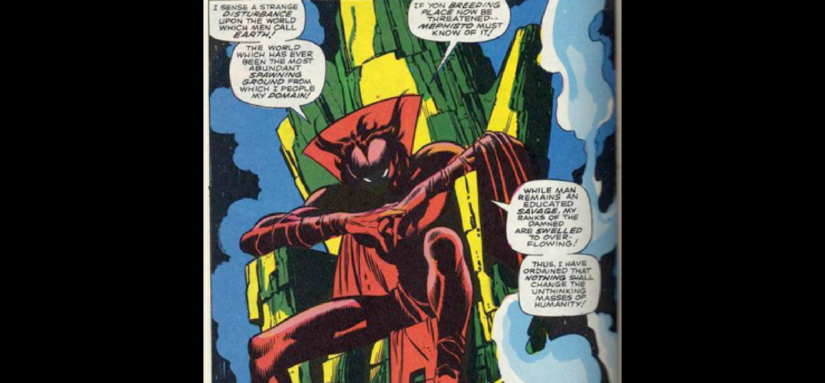
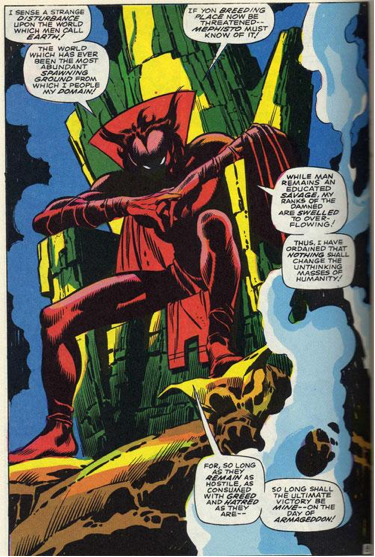
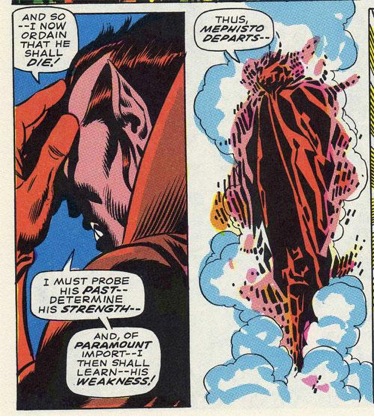

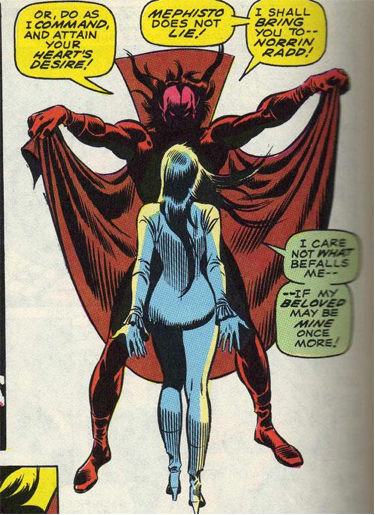
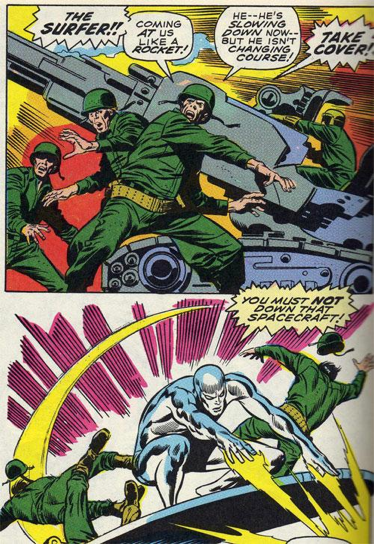




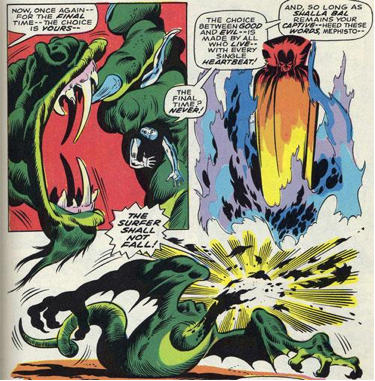

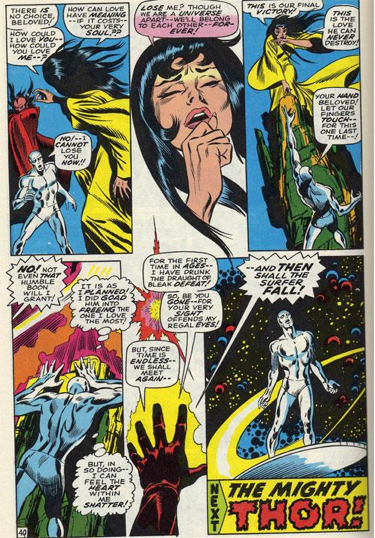

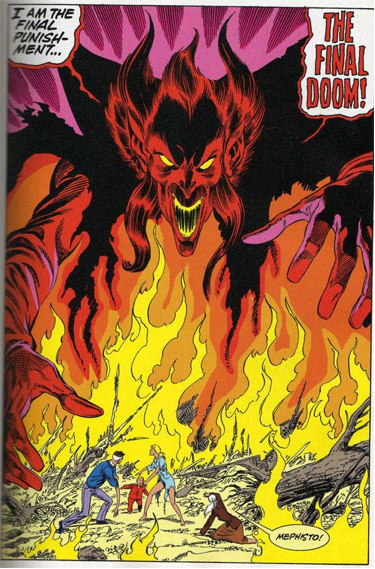

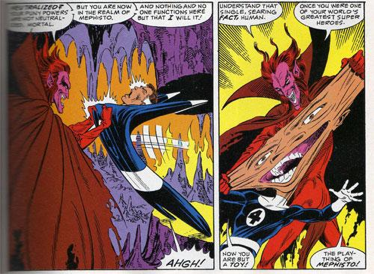

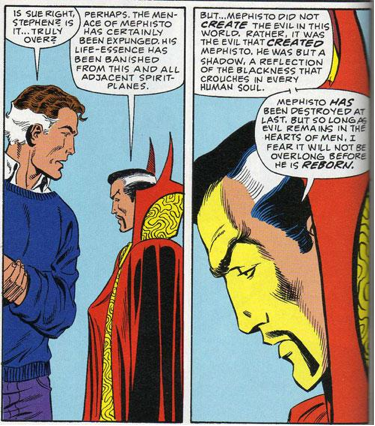
Comments are closed.